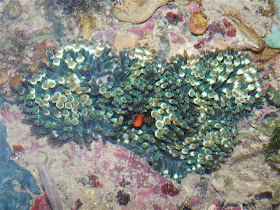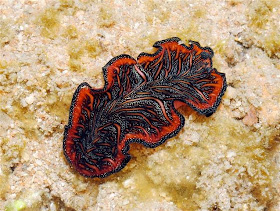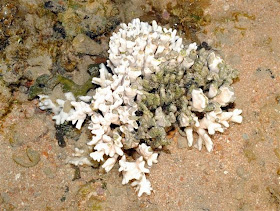A group of us led by Ron visited the island on Saturday morning and we were in time to catch the sunrise and its glow over the horizon. Most of them were first time visitors to the island!
There is a rich patch of corals situated right beside the channel between the two Sister's Islands. We took the opportunity of the low tide to have a good look at the reef patch.
At many areas, there were many hard corals of both branching and boulder forms that crowd the shore.
And since it was still dawn, the Bengal sergeants (Abudefduf bengalensis) were still happily swimming in the tide pools though we saw less of them when the sun came up.
Some special finds on this reef would be this Pizza anemone (Cryptodendrum adhaesivum).
This is another pizza anemone that indeed looks more like a pizza with an outer thicker crust. Haha!
What's Big Sister's Island without the Feather stars (Order Comatulida)? Here's a bright red one found among the crowded mosaic of corals, sponges and seaweed.
Though the visibility was not as ideal as my previous trip due to the strong currents from the channel, I could still take some decent shots of the magnificent corals and feather stars.
Here's another feather star perched on top of the Boulder pore coral (Porites sp.).
Taking a closer look at this feather star, I realized it is very pretty with brown fringe and white dots on its arms.
Here's another look at the colourful reef that exist at the slightly deeper ends of the shore. Nope, I did not snorkel nor dive to get this photograph with my underwater camera.
Ron and I spent some time admiring and taking photographs of an extremely cute Tomato anemonefish (Amphiprion frenatus) with its home, the Bulb-tentacled sea anemone (Entacmaea quadricolor).
After much perseverance and patience, here are two of the better shots taken using the DSLR camera.
And here's a more intimate and upfront shot of the cute juvenile clownfish taken using my underwater camera. How adorable!
I also came across what looks like a sea fan or gorgonian. However, it has polyps with 6 tentacles instead of 8 tentacles. Thus, it is not a sea fan! Ron suggested it could be a Black coral (Family Antipathidae)! Would be exciting to know if it really is because they are not usually found in shallow waters and it would be my first sighting!
The second half of the trip, we went to have a look at the big lagoon where marine life crept back over time. There are many hard corals, anemones and other amazing marine life in this lagoon!
I have missed the two Fluted giant clams (Tridacna squamosa) on my recent previous trips and am elated to see them with my own eyes. This first one is quite large and has very pretty brown and orangey patterns on its mantle.
Here's the second one with the top photo showing it exposed out of water and later revealing its blueish-green mantle when the tide returned.
Ron's wish was granted when his friends found not one but two Tiger-tail seahorses (Hippocampus comes)! This is a papa and what makes this papa special is that it can carry the eggs in his body become 'pregnant'.
Here's a look at the mama seahorse that was found nearby. The female can lay her eggs in the papa's pouch using a tube that looks very much like a penis. Inside his pouch, the eggs are fertilized and become embedded into the body walls.
Emerging from the eggs, the babies hatch as miniature seahorses and may remain in the pouch for a while before the papa goes into 'labour' and ejects them out of the pouch.
There were some Long spined black sea urchins (Diadema sp.) in the lagoon and they always look so intimidating with their super long spines.
It was by coincidence that I stopped and looked for a while before spotting this tiny Reliable nudibranch (Goniobranchus fidelis) with distinctive pattern. It's my second time seeing it at Big Sister's.
There are lots of critters hiding near and beneath the rocks and rubble at the higher shores. I came across 3 of these Lined chromodoris nudibranch (Chromodoris lineolata).
There was also this Persian carpet flatworm (Pseudobiceros bedfordi) which is richly patterned with orange, black lines and white spots.
There was even a wild Abalone (Family Haliotidae) originally found under a rock. With an encrusted flat shell, this animal is hard to spot.
The ones we eat are colder water species which grow much larger. Sadly, the over consumption of abalones may threaten wild populations and result in over collection of the smaller tropical species.
More intriguing finds beneath rocks include their bivalves found attached to the surface. They are probably leaf oysters.
This bivalve with jagged protrusions is a Jewel box clam (Chama sp.).
Could this be a juvenile version of the same type of Jewel box clam?
The Swimming file clam (Limaria sp.) is usually very active and they swim by flapping their shells. However, try to avoid touching their tentacles as they tend to shed off their own tentacles as part of its defense mechanism.
How nice to also spot this tiny orange sea star again! It is probably a type of Asterina sea star though the exact identity is still unknown.
It was sad to see that the Acropora corals (Acropora sp.) bleaching very badly and the rest of the colonies in the vicinity being decimated.
Here's another colony of another type of hard coral that is almost dead from bleaching. Could this be due to high heat?
It was a long low tide and we have indeed seen many interesting sightings and many of them went back with a new perspective of what our shores are made up of. :)

































No comments:
Post a Comment